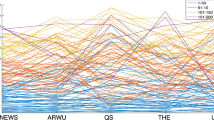Abstract
Composite indicators play an essential role for benchmarking higher education institutions. One of the main sources of uncertainty building composite indicators and, undoubtedly, the most debated problem in building composite indicators is the weighting schemes (assigning weights to the simple indicators or subindicators) together with the aggregation schemes (final composite indicator formula). Except the ideal situation where weights are provided by the theory, there clearly is a need for improving quality assessment of the final rank linked with a fixed vector of weights. We propose to use simulation techniques to generate random perturbations around any initial vector of weights to obtain robust and reliable ranks allowing to rank universities in a range bracket. The proposed methodology is general enough to be applied no matter the weighting scheme used for the composite indicator. The immediate benefit achieved is a reduction of the uncertainty associated with the assessment of a specific rank which is not representative of the real performance of the university, and an improvement of the quality assessment of composite indicators used to rank. To illustrate the proposed methodology we rank the French and the German universities involved in their respective 2008 Excellence Initiatives.




Similar content being viewed by others
References
Aguillo, I., Bar-Ilan, J., Levene, M., & Ortega, J. L. (2010). Comparing university rankings. Scientometrics, 85, 243–256.
Bastedo, M., & Bowman, N. (2010). College rankings as an interorganizational dependency: Establishing the foundation for strategic and institutional accounts. Research in Higher Education. doi:10.1007/s11162-010-9185-0.
Centre for Higher Education Development (CHE), UNESCO European Centre for Higher Education (CEPES), Institute for Higher Education Policy (IHEP). (2006). Berlin principles on ranking of higher education institutions, Berlin. Available online at: http://www.che.de/downloads/Berlin/Principles/IREG/TEXTsymbol/534.pdf.
Chen, Y., & Liu, N. C. (2008). Examining major rankings according to the Berlin principles. Higher Education in Europe, 33, 201–208.
Cook, J. M. (1958). Rational formulae for the production of a spherically symmetric probability distribution. Mathematical Tables and Other Aids to Computation, 11, 81–82.
Debreu, G. (1960). Topological methods in cardinal utility theory. In K. J. Arrow, S. Karlin, & P. Suppes (Eds.), Mathematical methods in the social sciences (pp. 16–26). Stanford: Stanford University Press.
Dill, D., & Soo, M. (2004). Is there a global definition of academic quality? A cross-national analysis of university ranking system. Public Policy for Academic Quality. Chapel Hill, NC: University of North Carolina.
Ding, J., & Qiu, J. (2011). An approach to improve the indicator weights of scientific and technological competitiveness evaluation of Chinese universities. Scientometrics, 86, 285–297. doi:10.1007/s11192-010-0268-7.
Federkail, G. (2008). Rankings and quality assurance in higher education. Higher Education in Europe, 33, 219–231.
Geraci, M., & Degli, M. (2011). Where do Italian universities stand? An in-depth statistical analysis of national and international rankings. Scientometrics. doi:10.1007/s11192-011-0350-9.
Harvey, L. (Ed.) (2008). Rankings of higher education institutions: A critical review. Quality in Higher Education, 14(3), 187–207.
Marsaglia, G. (1972). Choosing a point from the surface of a sphere. The Annals of Mathematical Statistics, 43, 645–646.
Pike, G. R. (2004). Measuring quality: A comparison of U.S. News Rankings and NSSE Benchmarks. Research in Higher Education, 45(2), 193–208.
Sadlak, J., Merisotis, J., & Liu, N. C. (2008). University rankings: Seeking prestige. Raising visibility and embedding quality—the Editors’ views. Higher Education in Europe, 33, 195–199.
Saisana, M., & D’Hombres, B. (2008). Higher education rankings: Robustness and critical assessment. JRC Scientific and Technical Reports, European Commission.
Saisana, M., Saltelli, A., & Tarantola, S. (2005). Uncertainty and sensitivity analysis techniques as tools for the quality assessment of composite indicators. Journal of the Royal Statistical Association A, 168, 307–323.
Stolz, I., Hendel, D., & Horn, A. (2010). Ranking of rankings: Benchmarking twenty-five higher education ranking systems in Europe. Higher Education, 60, 507–528.
Usher, A., & Savino, M. (2007). A global survey of university ranking and league tables. Higher Education in Europe, 32(1), 5–15.
Author information
Authors and Affiliations
Corresponding author
Appendices
Appendix 1. Monte Carlo schemes
Algorithm 1
-
(a)
Let w (0) = (w 1,…,w p ). Fix the radius s and the sample size m.
-
(b)
Generate p − 1 uniform values w (1)1 ,…, w (1) p−1 on (w 1 − s,w 1 + s), (w 2 − s,w 2 + s),…, (w p−1 − s,w p−1 + s), respectively.
-
(c)
If (1 − (w (1)1 ,…, w (1) p−1 )) belongs to the interval (w p − s,w p + s) then w (1) = (w (1)1 ,…, w (1) p−1 , 1 − (w (1)1 ,…, w (1) p−1 )), otherwise reject.
-
(d)
Iterate steps (b) and (c) to get w (1)… w (m).
Figure 5 shows the corresponding surface in ℜ3 for the initial vector of weights w (0) = (1/3,1/3,1/3) when the perturbations are generated around this point with s = 0.2w j following Algorithm 1.
Algorithm 2
-
(a)
Let w (0) = (w 1,…,w p ). Fix the radius s and the sample size m.
-
(b)
Generate p uniform values w (1)1 ,…, w (1) p on (w 1 − s,w 1 + s), (w 2 − s,w 2 + s), …, (w p − s,w p + s), respectively.
-
(c)
If (w (1)1 )2 +···+ (w (1) p )2 ≤ s 2, and w 1 (1) +…+ w p (1) = 1, then w (1) = (w (1)1 ,…, w (1) p ), otherwise reject and re-select p uniform values following step b.
-
(d)
Iterate steps (b) and (c) to get w (1)… w (m).
Appendix 2. Robust ranking using different values of the level of perturbation
Rights and permissions
About this article
Cite this article
Benito, M., Romera, R. Improving quality assessment of composite indicators in university rankings: a case study of French and German universities of excellence. Scientometrics 89, 153–176 (2011). https://doi.org/10.1007/s11192-011-0419-5
Received:
Published:
Issue Date:
DOI: https://doi.org/10.1007/s11192-011-0419-5





